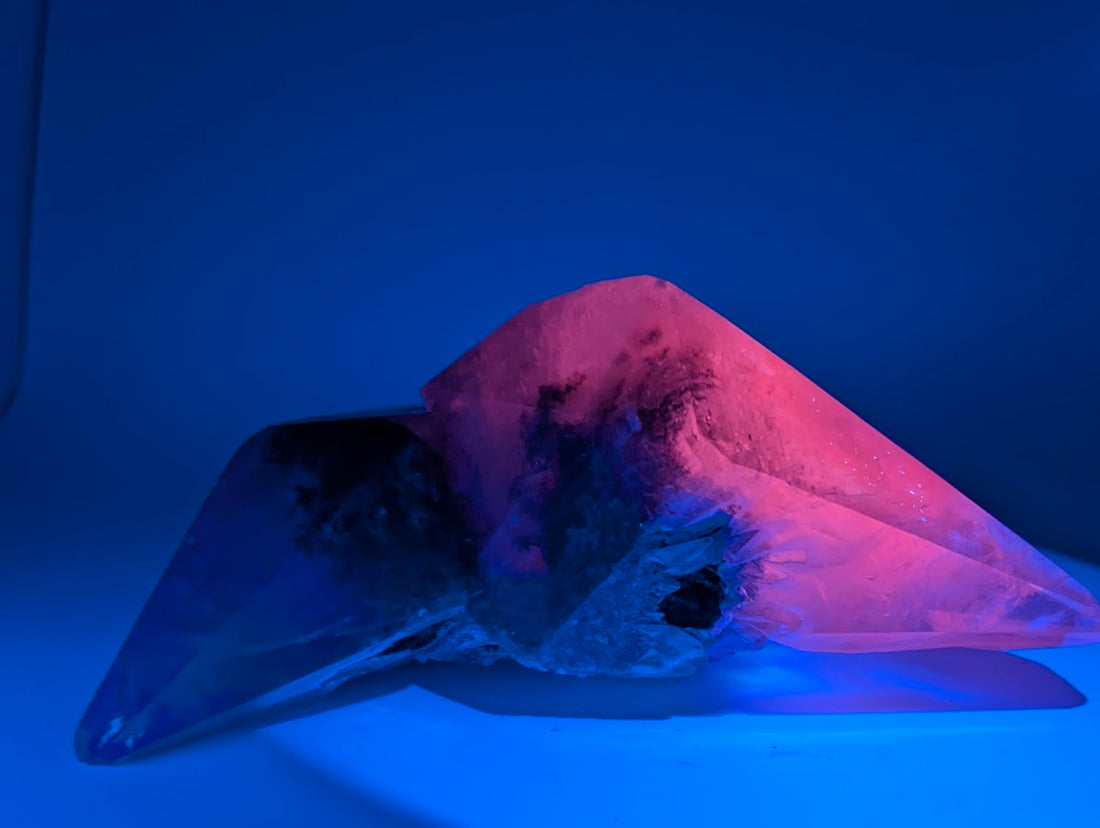
Fluorescent & UV-Reactive Minerals: A Visual Guide
Share
Some minerals hide their true colors until you shine the right light. Under ultraviolet illumination, they glow with an otherworldly radiance. From fluorite to calcite, UV-reactive minerals are among the most captivating in any collection. Here’s how fluorescence works, what to look for, and which specimens at Legacy Crystals and Minerals reveal this magical glow.
What Causes Fluorescence in Minerals?
Fluorescence occurs when certain elements within a mineral absorb ultraviolet light and re-emit it as visible light. This reaction can cause crystals to glow in vivid hues—often pink, green, blue, yellow, or purple—depending on trace impurities like manganese, uranium, or rare-earth elements.
Not every specimen from a fluorescent mineral species will glow; the effect depends on trace chemistry, structural integrity, and wavelength exposure. That’s part of what makes collecting fluorescent minerals so addictive—no two pieces are exactly alike under UV light.
Understanding UV Light Types
- Longwave UV (365 nm): The type used in blacklight displays. Gentle, safe for most specimens, and reveals subtle fluorescence.
- Shortwave UV (254 nm): Higher energy, used by serious collectors. It can reveal strong or contrasting colors but should be used carefully, as it can fade or damage light-sensitive minerals.
Famous Fluorescent Minerals
- Fluorite: The most famous fluorescent mineral. It glows blue, violet, or green depending on locality. Explore fluorite specimens from Inner Mongolia, Zhejiang, and Fujian, each with its own UV signature.
- Calcite: May glow in shades of pink, red, or orange due to manganese content.
- Willemite: Emits brilliant green light, often paired with red calcite in Franklin, New Jersey specimens.
- Hackmanite: A variety of sodalite that exhibits tenebrescence—it changes color when exposed to light and then slowly reverts back.
- Yooperlite: A sodalite-bearing syenite discovered along the shores of Lake Superior in Michigan. Under longwave UV, it ignites in fiery orange-yellow patterns as fluorescent sodalite veins glow within the gray matrix. Its name comes from “Yooper,” a nickname for Upper Peninsula residents. Explore Yooperlite pieces for both collectors and energy workers.
- Aragonite & Hydrozincite: Show blue or white fluorescence, often found in combination with calcite veins.
- Quartz with Hematite or Rutile Inclusions: Can show red or orange phosphorescence after exposure.
Collector Appeal of Fluorescent Minerals
Fluorescent specimens are an experience as much as a display piece. They add an interactive element to collections and museum cases. The same mineral can appear calm under daylight yet transform into a glowing landscape under UV.
Collectors value them for their scientific intrigue and their beauty. Owning one is like possessing two specimens in one—a natural marvel and a visual performance.
Metaphysical & Symbolic Interpretations
For metaphysical seekers, fluorescent minerals symbolize illumination, revelation, and hidden energy. They remind us that there is always more beneath the surface, encouraging intuition and insight. Fluorite, for example, is said to illuminate the mind, while calcite amplifies clarity and creativity.
How to Display Fluorescent Minerals
- Dedicated UV Display Cases: Install LED blacklights or UV bars with proper shielding to protect viewers and minerals.
- Dual Lighting: Combine soft white light for daytime viewing and UV light for nighttime shows.
- Contrast & Background: Matte black or dark backgrounds enhance visible fluorescence.
- Rotation: If displaying shortwave-reactive pieces, limit exposure time to preserve intensity.
Fluorescent minerals pair beautifully with museum-grade pieces or as conversation starters in modern home displays.
Fluorescent Minerals at Legacy
Our fluorite and quartz specimens often feature UV reactivity, with blue or violet glows under longwave light. We also carry select calcite and willemite combinations that showcase classic fluorescence. Each specimen is tested and labeled for transparency and collector confidence.
Spotlight: Yooperlite – The Modern Classic
Discovered in 2017 along Michigan’s Lake Superior, Yooperlite captivated collectors and crystal enthusiasts with its dramatic glow under longwave UV. By day, it appears as a speckled gray matrix; under UV, fluorescent sodalite veins blaze in orange-yellow patterns. For collectors, Yooperlite represents a fresh chapter in fluorescent mineral history; for metaphysical seekers, it symbolizes hidden potential and illumination.
At Legacy, we carry Yooperlite spheres and carvings that highlight its natural patterning and energetic brilliance under UV light.
Shop Our Collection | Explore More Guides
Quick Tips for Collectors
- Use proper eye protection when working with shortwave UV.
- Store fluorescent minerals away from prolonged direct sunlight.
- Document your UV results—video footage adds value and fascination for future buyers or exhibits.
Fluorescent Mineral Index
A quick reference for collectors and enthusiasts to identify which minerals glow under UV light, their common colors, and where they’re often found.
| Mineral | Typical Glow Color | UV Type | Notable Localities | Explore |
|---|---|---|---|---|
| Fluorite | Blue, Violet, Green | Longwave / Shortwave | Inner Mongolia, Zhejiang, England | Shop Fluorite |
| Calcite | Pink, Red, Orange | Shortwave | Mexico, New Jersey, China | Shop Calcite |
| Willemite | Bright Green | Shortwave | New Jersey, USA, China | Shop Willemite |
| Hackmanite (Sodalite) | Pink to Violet | Longwave | Greenland, Afghanistan, Canada | Shop Sodalite |
| Yooperlite (Sodalite Syenite) | Fiery Orange–Yellow | Longwave | Lake Superior, Michigan, USA | Shop Yooperlite |
| Aragonite | Blue-White | Shortwave | Morocco, Mexico | Shop Aragonite |
| Quartz (with Inclusions) | Orange-Red Phosphorescence | Longwave | Fujian, Tamil Nadu, Brazil | Shop Quartz |



